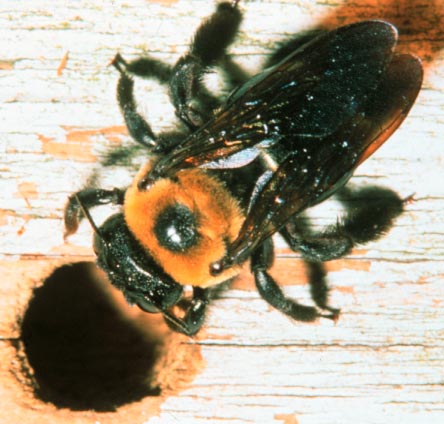
A carpenter bee, Xylocopa sp. (Hymenoptera: Xylocopidae), nest opening. Photo by G. McIlveen, Jr.
Common Name: Carpenter bee
Scientific Name: Xylocopa sp.
Order: Hymenoptera
Description: Adult carpenter bees are large (3/4 to 1 inch long) and resemble bumble bees except that the abdomen is hairless and shiny black rather than being covered by patches of orange to yellow hair found on bumble bees. The carpenter bees in the genus, Ceratina, are much smaller (1/4 inch) and are dark bluish-green, and make nests in plant stems.
Life Cycle: Adults spend the winter in nests constructed the previous year, and become active in April or May. After mating, females construct new nesting tunnels or use pre-existing tunnels. Nesting tunnels are about ½ inch wide and start on the end of wooden beams or at right angles to a surface for ½ to 1 inch before turning and following the wood grain. Tunnels are clean cut and may extend 6 to 8 inches. Females collect pollen and nectar to produce a dough-like mass called “bee bread.” Eggs hatch into larvae that feed on the bee bread in their cells. Development varies with species and temperature, but can progress from egg to adult in a little over a month. There may be two or three generations per year. Continuous generations may occur in south Texas. Adults emerging in late summer or fall do not mate until spring but may gather and store pollen in their tunnels.
Habitat, Food Source(s), Damage: They prefer unfinished softwoods such as redwood, cypress, cedar and pine in structures for constructing nests. Carpenter bees do not consume wood like termites, but use wood merely to construct nests. While gathering nectar and pollen carpenter bees pollinate flowers.
Pest Status: Adult female carpenter bees can sting but usually only if aggressively molested; most carpenter bees “attacking” people passing by nesting sites are territorial males incapable of stinging; structural damage produced by nest-making activities can be somewhat damaging to homes, garages, fences and other buildings, although damage is largely cosmetic unless nesting sites are used repeatedly over years.
For additional information, contact your local Texas A&M AgriLife Extension Service agent or search for other state Extension offices.
Literature: Borror et al. 1989; Hamman & Owens 1981.